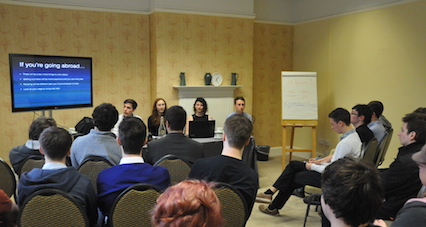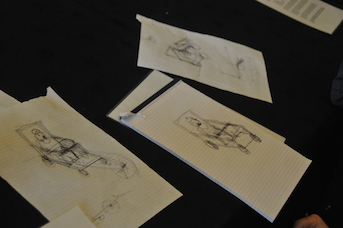| If you are registered for a degree that requires you to undertake an industrial placement, then you have to produce a report on your year out; the marks awarded for this report constitute 50% of the assessment of your industrial year, through which the report contributes to your final degree assessment. This page is also available as a pdf version of the IY Report Guidelines. |
The report must be handed in at the beginning of the year when you return to the university. Check the Industrial Year web page for details of exactly when and in what form the report should be submitted. The report must be handed in at the beginning of the year when you return to the university. You must leave enough time to have the document approved by your company if this is necessary to comply with their confidentiality requirements. Check with your line manager well in advance and, if at all possible, avoid including confidential or commercially sensitive information in the report.
Report Content Guidelines
Because students' experience on their industrial years is so varied, we do not prescribe a structure for the reports. Nevertheless, most reports will include the following elements:
- a description of the organisational environment in which you worked;
- a description of the technical and application environments in which you worked;
- a description of the work you carried out;
- a critical evaluation of the experience you gained.
Organisational Environment
This is concerned with the nature of the organisation for which you worked and your place within the organisation. It might, for example, contain paragraphs like the following:
Megalomaniac Enterprises is a conglomerate operating in over 120 countries, with its head office in Liechtenstein. It is a private company owned and run by a Mr Aurwen Geldmann. Its operations range from mining to pharmaceuticals and from laundries to banks. There are 37 separate operating companies within the group.
During my industrial year I was employed by one of the banking subsidiaries, the Burma Rangoon International Banking Emporium, at its London office near the Houses of Parliament. The London office is divided into four divisions, three operational divisions (private banking, commercial banking, special services) and a common services division. The common services division is responsible for providing infrastructure (e.g. computing and telecommunications) for the rest of the office. I worked in the communications department of the common services division.
Within the communications department, there are several separate teams. I was initially assigned to the maintenance team and given particular responsibility for the local area network in the office. After the first three months I was offered the opportunity, which I accepted, to transfer to the special projects team. Although this team reported up to the head of the London office, in the normal way, it also, on occasions, received instructions direct from Mr Geldmann himself.
If you worked for a large company, this section is likely to be quite lengthy. If you worked for a small company, it may be quite short.
Technical and Application Environments
In this section you should describe the hardware and software environment within which you worked. This should be reasonably comprehensive without being too detailed, e.g.
The computer I was given for my own use was a Dell tower with an Intel i7 processor, 8GB of memory and a 500GB hard disk. This computer was connected to a 100Mbps internal network with MAC address identification to access internal services. The network was split into two sub-networks at the internet router, one for the internal wired network and the other for the wireless network. The wireless network was split this way to prevent wireless access to internal services without authentication. Authentication can be gained by using a VPN to connect to the internal network. The company operates a set of local servers mostly from Dell with one from Oracle. The Dell servers are used as SCM (Software Configuration Management) and FTP (File Transfer Protocol) servers, and as internal web servers. There are two source control servers, one of which is internal only and the other of which is externally accessible. These support CVS, SVN and Git. (CVS is a public domain client-server revision control system; SVN - Apache Subversion - is a software versioning and revision control system available under the Apache licence; and Git is a distributed revision control system, originally used for the development of the Linux kernel.) The Dell servers also contain web based software for browsing the repositories. There is also a Windows domain server, which mirrors a server in Paris, and the Oracle server is used for virtualisation. . . . and so on.
(Note the way in which acronyms are explained on their first appearance.)
It may well be appropriate to include some comments on your experience with this environment. Under the application environment heading, you should describe what the computer systems you worked on were doing, e.g. general ledger, production control. You need to put in enough detail for someone who is unfamiliar with the application area to understand what is going on. In some cases, this may be a suitable place to describe the flow of information, etc., within the environment.
What You Did
This should start with a clear and well-structured summary, e.g.
When I joined the company, I was sent on a four week training course to learn how to write Ruby, and how to use the various utilities that were in regular use in the department. The course also introduced me to the company's standards and procedures.
On completion of the course, I joined the five person team responsible for maintaining the purchase ledger system. The main task of the team at that time was to modify the system so that managers could make on-line enquiries about outstanding purchase orders. I was given two small programs to write and conduct unit tests on. A detailed design for each of the programs was already available. The programs were each about 200 statements long; writing and testing the two took me about eight weeks.
I was then asked to help in producing the test data for the on-line version of the system. This involved careful reading of the functional specification and I came to understand fully what the system did. Along with a systems analyst, it took me ten weeks to produce the necessary data. The test data was reviewed by other members of the team and we took a further two weeks to incorporate the modifications requested. . . .
You should then pick out and amplify, in separate subsections, those parts of your work that seem the most interesting.
Critical Evaluation
This is the place where you should say what you learned from the experience and in what respects it was good or bad. You should try to avoid being trivial. The following are the sort of comments that might appear:
I was surprised at the extent of the testing that was carried out. From my course, I knew that testing was important but I hadn’t realised that this meant going systematically through the functional specification and testing every statement it made about the functions of the system. It took longer to test a module than to write it.
Given how seriously testing was taken, it was odd to find that other forms of quality management were almost non-existent. There was no formal reviewing of specifications and there were no code walk-throughs. There was no configuration management and several errors occurred because wrong versions of modules were used.
Technically, I don't think I learned a lot from my year, except how to write Ruby - an experience which I hope never to have to repeat! However, I learned a lot about the way software development teams work and what it means to have real users.
As well as discussing what you learned from a technical point of view, you should try to say something about your non-technical experiences, in such areas as teamwork and communication.
Structure and Presentation
We do not prescribe the length of the report. However, unless you write very well indeed, you are unlikely to be able to say all that needs to be said in fewer than 5000 words. Equally, you may find it difficult to retain the reader's attention if it is much longer than this - and bored readers are not likely to award high marks.
The report structure should help readers to understand the report and find their way around it. The report should be divided appropriately into numbered sections and subsections; there should be a table of contents and the pages should be numbered. The section and subsection headings should indicate accurately what is in them. A common failing is to include material in one section or subsection that really belongs somewhere else, for example, putting a sentence explaining how travelling expenses were paid into the section describing the hardware you were using. Sometimes, of course, there may be several places in which a particular piece item might reasonably be placed; in such cases you should generally try to avoid duplicating the material.
Many industrial placements involve using specialised software referred to by a set of initials, e.g. STAP. The first time you mention a piece of software in this way, you should explain what the initials stand for and what, very briefly, the software does. For example, "In order to comply with company standards, I had to use STAP (Software Testing Aid for Python). This a package supplied by Llanilar Software Ltd which is used to generate sets of test cases."
Unless you are very confident of your ability to write well, we recommend that you ask someone else to read through the report and comment on it. This is one way of improving the way you write. If you make significant changes as a result of other people's comments, you should acknowledge their contribution. You will not be marked down for this.
Make sure that you run the final version of the report through a spell checker and grammar checker before you submit it.
Assessment Criteria
Threshold criteria
In order to pass (i.e. to get a mark of 40% or more) the report must:
- be in a typographically and structurally appropriate format, with comparatively few grammatical, typographical or stylistic errors;
- explain the core purpose or functions of the organisation for which you worked;
- describe the environment - technical and organisational - within which you were working;
- describe what you were during your time in industry.
A report that meets all of the criteria listed above will receive a mark of at least 40%; a report that does not meet all of the criteria will receive a mark of less than 40%. It is rare that a student who has completed a placement satisfactorily submits a report that gets a mark of less than 40%.
80% upwards
A report in this range must be of a standard that would do credit to a professional consultant working for a prestigious firm. This means it will:
- be typographically more or less faultless and free from grammatical errors;
- be clear, concise and free of unnecessary jargon, particularly "management-speak";
- be free from factual errors or misconceptions;
- enable the reader to understand easily and accurately what the organisation you were working for does and what your role in its activities was. To achieve this you will have to select the material you include judiciously and structure it appropriately;
- give a clear picture of the environment in which you worked;
- demonstrate a through understanding of both the good and the bad aspects of the environment in which you were working, including, for example, limitations of the organisation's business model.
Few students are capable of producing work of this standard but there are usually one or two in each year.
70 to 79%
A mark in this range indicates a report that would be acceptable from a professional consultant but is definitely capable of improvement. Such a report will have the following characteristics:
- there are few typographical errors and any grammatical errors are minor;
- while the report is generally clear and concise, there are sentences or paragraphs that are too long or complicated, and passages that are obscure because of the jargon they use;
- any factual errors or misconceptions are comparatively minor;
- while the report will give the reader a good overall picture of what the organisation you were working for does and what your role was, there will be some gaps or areas of confusion;
- the description of the environment in which you worked will be generally clear but there may be one or two areas that are confused;
- while the report will demonstrate an understanding of both good and bad features of the environment, the understanding may not extend to some of the more profound issues.
Experience suggests that, in most years, somewhere between 20 and 30% of the reports will be of this quality.
60 to 69%
A mark in this range indicates a report that can be considered a good piece of student work but is not of professional standard. Typically,
- there will be few typographical or grammatical errors;
- the material will be factually correct but there will be significant gaps;
- the description of the work you did and the company’s activities will be pedestrian and unselective;
- the assessment of the benefit you obtained from the year out will be sensible and realistic but the critical evaluation of the environment will be superficial.
50 to 59%
A report receiving a mark in this range will give a reasonable picture of the organisation you worked for and what you did during your year but it will have significant shortcomings and would need to be completely rewritten before it could be sent to a client. Examples of likely weaknesses are:
- there will be typographical or grammatical errors on most pages;
- some passages in the report will be difficult to understand because they are badly written;
- the report will contain significant factual errors, misconceptions or gaps;
- the report will give the reader a one-sided view of the organisation or the work you did during your year;
- while the report describes adequately the benefits that you obtained from your year out, there is no assessment of the environment in which you were working.
40 to 49%
A report in this range will contain enough information for the reader to understand in broad terms what the company you worked for does and what you did while working for it. It will, however, have substantial shortcomings, such as:
- frequent typographical and grammatical errors;
- much of the report will be difficult to read because of the way it's written or because it's badly structured;
- there will be significant gaps in coverage, as well as significant errors and misconceptions;
- the report will give a very narrow view of what the company does and what you did during your year;
- the report will contain little, if any, assessment of the environment or the benefits you got from the year.
A mark in this range is usually the result of lack of effort and leaving things to the last minute.
30 to 39%
While containing a significant amount of correct and relevant material, a report that gains a mark in this range will fail to address at least one of the key areas as well as being badly written and difficult to understand. It is rare that a student who has completed a placement satisfactorily gets a mark as low as this.
less than 30%
A report that fails to address the key areas - what the company does, the environment in which you worked and what you did - will get a mark in this range. It normally indicates that you have failed to take the requirement to produce a report seriously.
MFB
10.5.95
Revised 11.9.96, 1.9.99 MFB
Revised 9.10.03, 7.8.09 AIS
Revised 25.1.11, 27.10.12, MFB
Revised and assessment criteria added 10.1.15 MFB
Revised 26.9.15 MFB
| This page is maintained by Neal Snooke (This email address is being protected from spambots. You need JavaScript enabled to view it.). |




